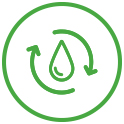Energy security and efficiency

Canterbury's high-country lakes provide water storage capacity that can enable renewable energy generation technologies. Investigating hydro-power options, particularly where they have additional benefits or enable 'dual-use' of the water (e.g. in combination with farm irrigation), is encouraged. New irrigation infrastructure developments consider options for hydroelectric power generation and are designed to utilise the landscape to convey water under pressure where feasible. This can minimise the need for pumping and, as a result, improve energy efficiency.
Here's how things are progressing against 2025 goals.
Energy security and efficiency
By 2025: Established measures for the productivity of electricity - per hectare consumption for irrigation sector and equivalent measures in other sectors.
Has this goal been met?
Regional measures have not been established across sectors.
A recent survey of large Canterbury irrigation schemes shows that the industry is mindful of energy use and actively looks to implement ways to reduce electricity consumption. Reported methods include the use of pumped water where water supply can be pressurised by gravity via piped distribution.
Further assessment is required to understand equivalent measures for consumption in other sectors.
Central Plains Water Ltd. Annual Report 2024 notes the cost incentives to reduce electricity consumption.
Demand management programmes run by drinking water suppliers will continue to minimise energy use.
By 2025: Continue to maintain or increase Canterbury’s contribution to New Zealand’s security of electricity supply.
Has the goal been met?
Electricity generation from existing plants continues, while enhancement of existing plants is underway. New generation facilities, particularly solar, are also being developed as shown in highlights below.
- Manawa Energy is carrying out an asset refurbishment programme including generation uplifts for Highbank and Coleridge power stations.
- In 2023, Meridian Energy applied for a resource consent with Environment Canterbury for continued operations of the Waitaki Power Scheme under the Resource Management Act. The application is still awaiting decision.
- Merdian Energy operates six hydro power generation stations generating electricity each year for about 832,000 average New Zealand homes.
- Genesis Energy operates using water from Lake Takapō/Tekapo for hydro power generation.
- Genesis Energy operates the Lauriston Solar Farm, the largest operational solar farm in New Zealand to date.
- A number of players in the irrigation industry are integrating small hydropower plants in an integrated water delivery system. An example of this is the BCI hydro electricity generator near Barrhill.
Both the Electricity Authority and Transpower have dashboards indicating potential future generation projects across New Zealand. These planned works are dominated by renewables including solar and wind generation opportunities rather than hydropower.
By 2025: Factored efficient use of electricity in all irrigation infrastructure.
Has the goal been met?
There is insufficient information to assess whether all irrigation infrastructure has had efficient use of electricity factored into its design and operation.
However, a recent survey of the region’s major irrigation schemes identified that industry is exploring a number of interventions to use electricity more efficiently, such as: hydropower generation within irrigation infrastructure, harnessing pressure in downhill sloped systems to displace grid electricity use, and participation in pilot studies run by Transpower.
- A number of players in the irrigation industry are integrating small hydropower plants in an integrated water delivery system. An example of this is the BCI hydro electricity generator near Barrhill.
- In 2021, the Energy Authority commissioned a review of Transpower’s Demand Response programme to better understand New Zealand’s market conditions for future investment in renewable energy generation.
Rising energy costs will continue to incentivise efficient use of electricity in the irrigation sector as with other industries.
